Why you can trust Tom's Hardware
Comparison Products
Today, we pit the Seagate IronWolf 110 NAS SSD against its arch-nemesis, the WD Red SA500, also at a 4TB capacity. As well, we threw in some other SATA contenders including the Samsung 860 EVO, Crucial MX500, and a WD Black HDD. Additionally, we’ve included the Adata XPG SX8200 Pro, one of our favorite M.2 NVMe SSDs, as well as a WD Blue SN550 and a speedy PCIe Gen4 SSD, the Corsair Force MP600 for good measure. Those last two drives are also M.2, rather than the SATA drives' 2.5-inch form factor.
Game Scene Loading - Final Fantasy XIV
The Final Fantasy XIV StormBlood and Stormbringer are two free real-world game benchmarks that easily and accurately compare game load times without the inaccuracy of using a stopwatch.


Being built for sustained write workload performance, Seagate’s IronWolf 110 isn’t the highest-performing SATA SSD for this read focused gaming benchmark. It scores seventh place overall, but it is much faster than an HDD.
Transfer Rates – DiskBench
We use the DiskBench storage benchmarking tool to test file transfer performance with our own custom blocks of data. Our 50GB data set includes 31,227 files of various types, like pictures, PDFs, and videos. Our 100GB includes 22,579 files with 50GB of them being large movies. We copy the data sets to new folders and then follow-up with a reading test of a newly written 6.5GB zip file, 8GB test file, and a 15GB movie file.

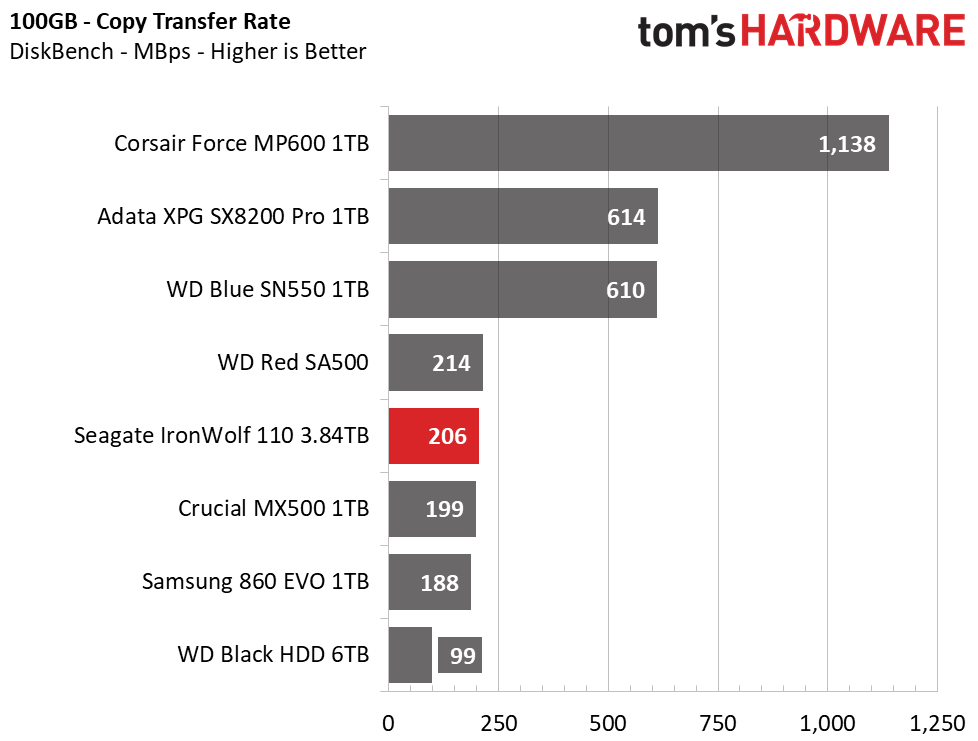



Seagate’s IronWolf 110 scores fifth place in the 50GB copy, just a few MBps shy of the Samsung 860 EVO, and it leads the WD Red SA500. But once we throw the 100GB copy test at the group, we see the NAS SSDs take the lead over the Samsung 860 EVO and Crucial MX500.
Unlike most consumer drives, the Seagate IronWolf 110 and WD Red lack of an SLC write cache, thus they are best suited for sustained write performance, especially at smaller capacities. However, they aren’t quite as optimized for reads as the Samsung and Crucial because of this. Compared to the standard HDD, the Seagate offers a nice boost in performance, though.
Trace Testing – PCMark 10 Storage Tests
PCMark 10 is a trace-based benchmark that uses a wide-ranging set of real-world traces from popular applications and common tasks to measure the performance of storage devices. The quick benchmark is more relatable to those who use their PCs lightly, while the full benchmark relates more to power users. If you are using the device as a secondary drive, the data test will be of most relevance.
Get Tom's Hardware's best news and in-depth reviews, straight to your inbox.
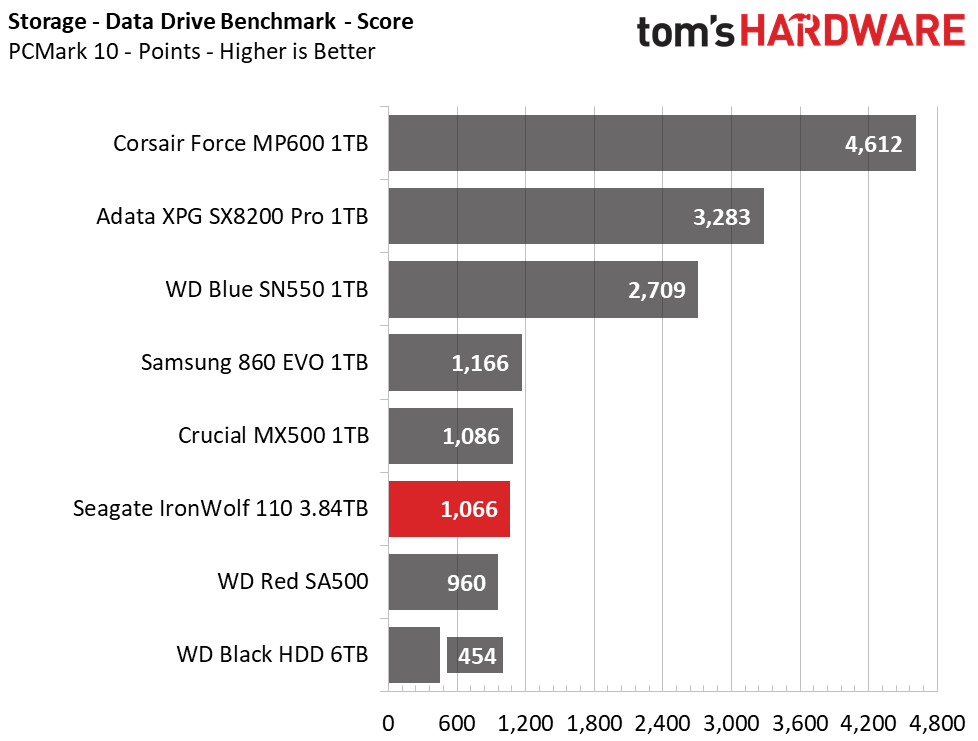

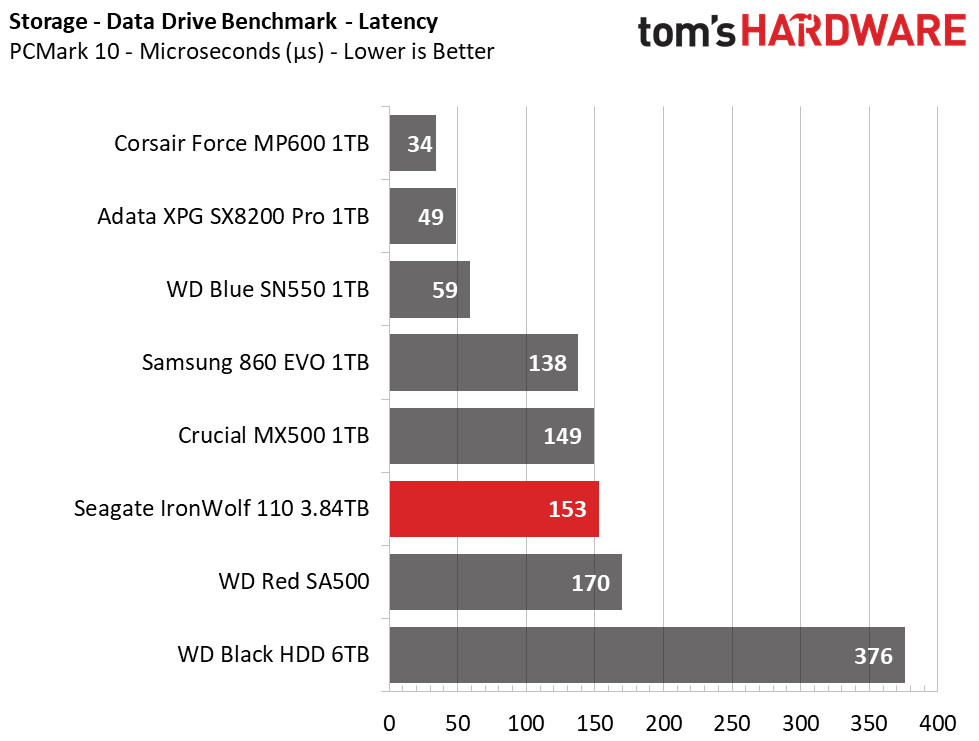






The IronWolf 110 is close in performance to other SATA SSDs, but without a bursty SLC cache, it falls behind a bit compared to the Crucial and Samsung. Overall, Seagate’s IronWolf 110 scores sixth place in both the Data Drive and Quick System Drive benchmarks and falls into seventh in the Full System Drive benchmark when things are turned up a notch.
Trace Testing – SPECworkstation 3
Like PCMark 10, SPECworkstation 3 is a trace-based benchmark, but it is designed to push the system harder by measuring workstation performance in professional applications.



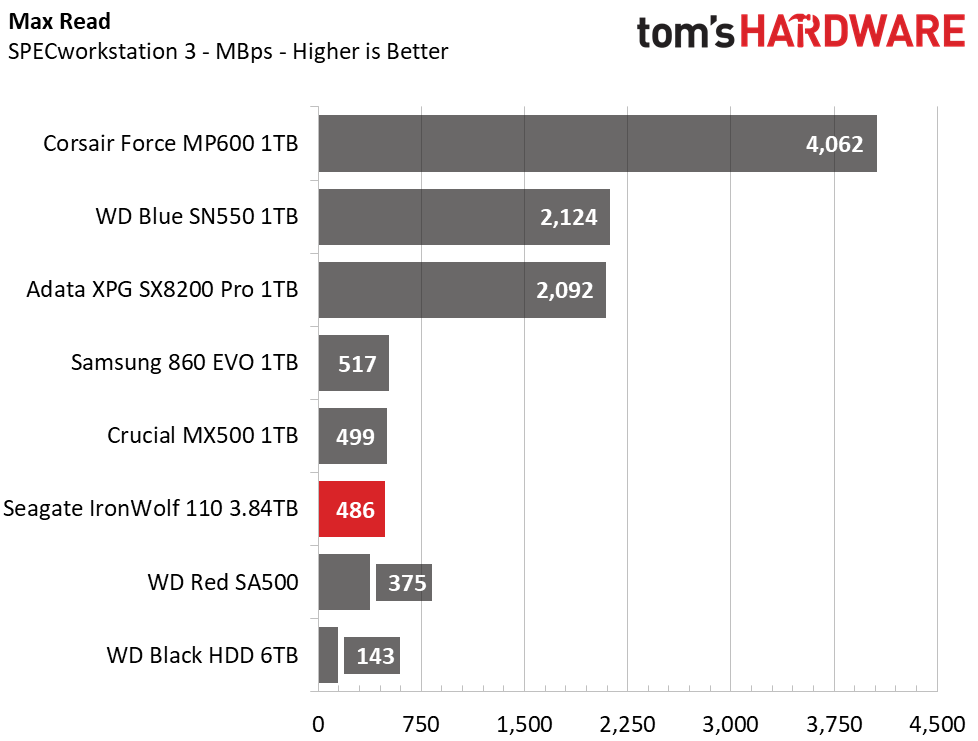
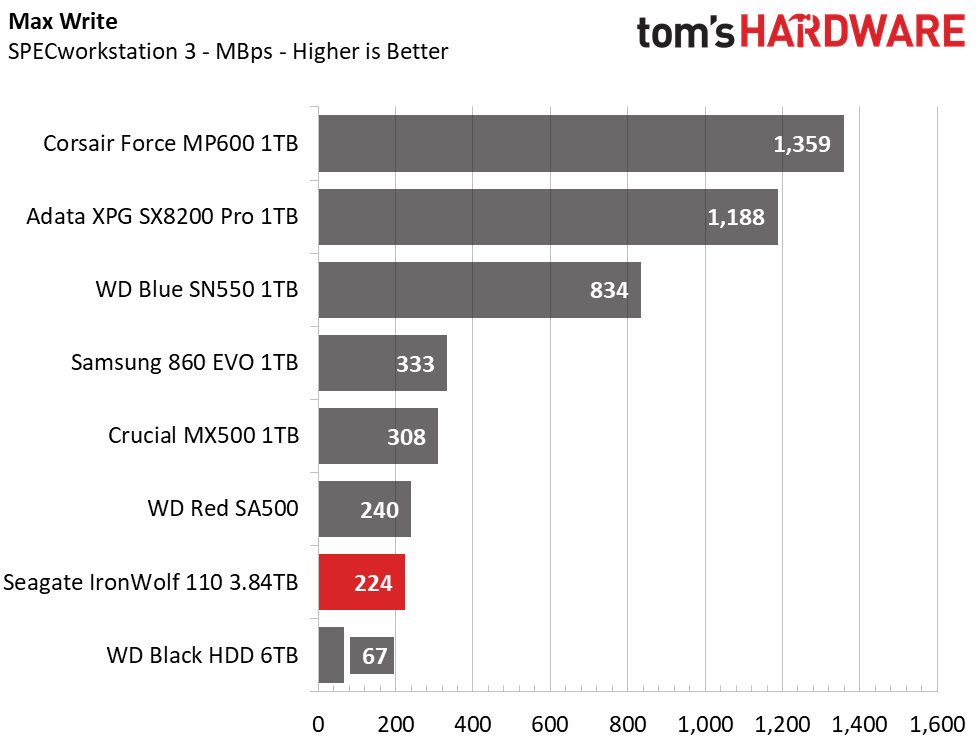
Like in PCMark 10, the Seagate IronWolf 110’s performance compares closely with other SATA SSDs, but lags the NVMe competition. It was able to best the WD Red SA500 here though, completing the test a few minutes faster. It scores sixth place overall and offers a significant improvement in performance over the standard HDD.
Synthetics - ATTO
ATTO is a simple and free application that SSD vendors commonly use to assign sequential performance specifications to their products. It also gives us insight into how the device handles different file sizes.


In ATTO, we tested Seagate’s IronWolf 110 at a QD of 1, representing most day-to-day file access at various block sizes. When it comes to reading, the Seagate lags behind the other SATA SSD at the smaller file sizes. The Seagate’s performance doesn’t catch up until the 512KB block size. But, on the other hand, write performance is on par with most SATA SSDs. The IronWolf 110’s Performance here peaks at 517/469 MBps, doubling the HDD’s.
Synthetic Testing - iometer
iometer is an advanced and highly configurable storage benchmarking tool that vendors often use to measure the performance of their devices.








On our X570 platform, the IronWolf 110’s sequential performance peaked at 529/496 MBps read/write, and again, write performance is a bit better than read. Random performance is lacking a bit at QD1. Seagate’s IronWolf 110 displays higher random latency at QD1 than the WD Red SA500 and almost triple the latency of the Adata XPG SX8200 Pro. Still, while not the most responsive drive available, this is practically light speed compared to an HDD, especially once you send it more than one request at once.
Sustained Write Performance, Cache Recovery, and Temperature
Official write specifications are only part of the performance picture. Most SSD makers implement a write cache, which is a fast area of (usually) pseudo-SLC programmed flash that absorbs incoming data. Sustained write speeds can suffer tremendously once the workload spills outside of the cache and into the "native" TLC or QLC flash. We use iometer to hammer the SSD with sequential writes for 15 minutes to measure both the size of the write cache and performance after the cache is saturated. We also monitor cache recovery via multiple idle rounds.
When possible, we also log the temperature of the drive via the S.M.A.R.T. data to see when (or if) thermal throttling kicks in and how it impacts performance. Bear in mind that results will vary based on the workload and ambient air temperature.





As mentioned previously, the Seagate opted to do without an SLC write cache on the IronWolf 110. Our sample was able to write at a sustained rate of 495 MBps indefinitely, which is exactly how an enterprise-grade SSD should perform. As well, when moving around a few hundred gigabytes of data at once, the maximum temperature reported was under 45C in our 25C environment with static air (no airflow).
Power Consumption
We use the Quarch HD Programmable Power Module to gain a deeper understanding of power characteristics. Idle power consumption is a very important aspect to consider, especially if you're looking for a new drive for your laptop. Some SSDs can consume watts of power at idle while better-suited ones sip just milliwatts. Average workload power consumption and max consumption are two other aspects of power consumption, but performance-per-watt is more important. A drive might consume more power during any given workload, but accomplishing a task faster allows the drive to drop into an idle state faster, which ultimately saves power.
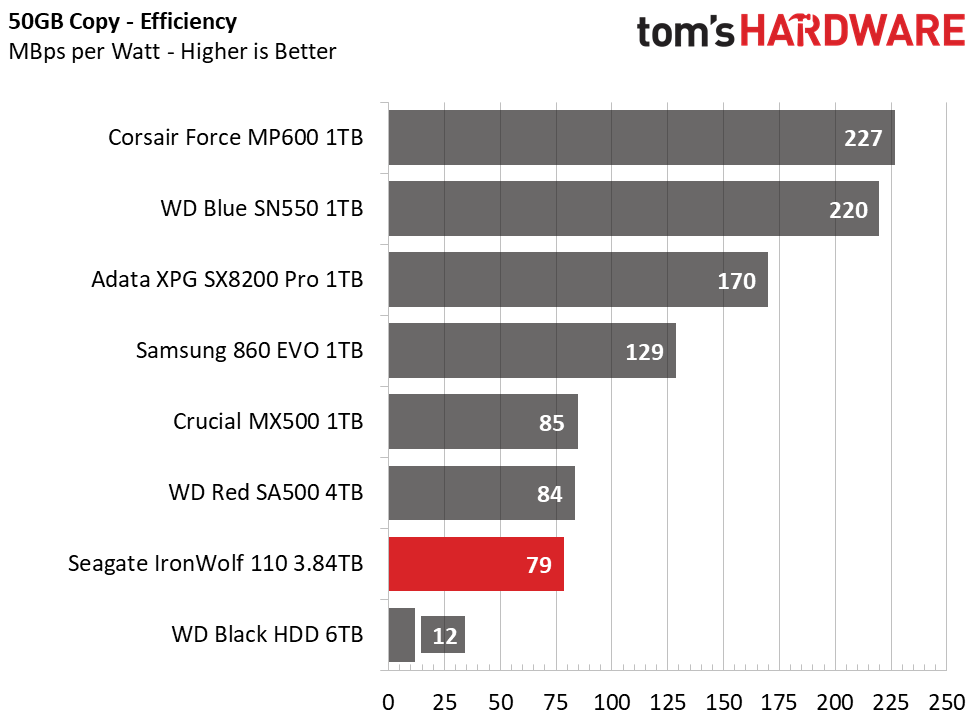
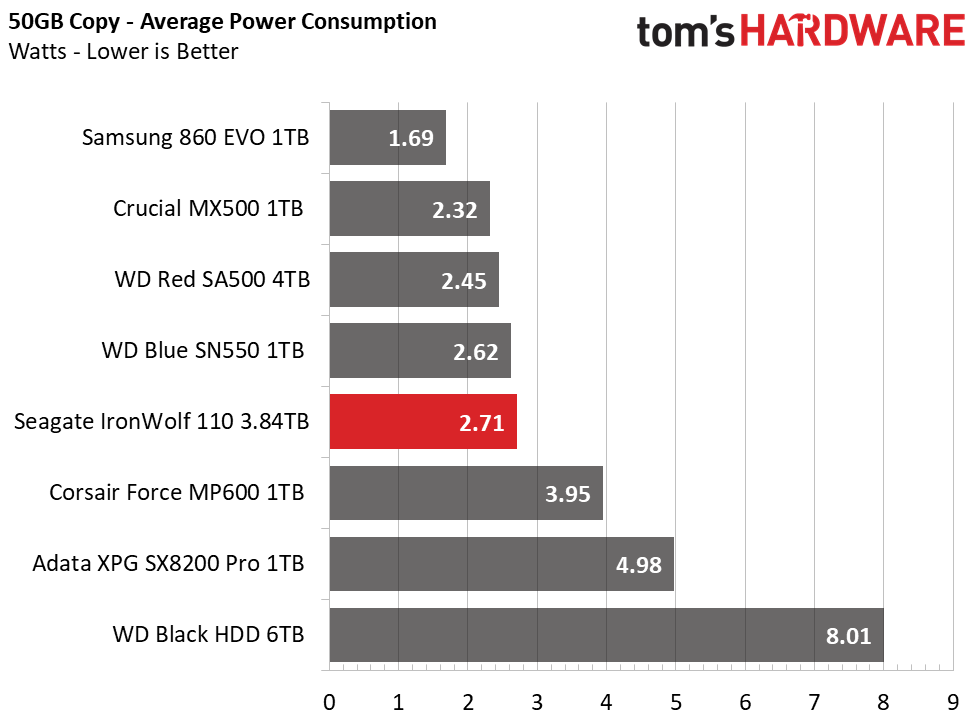



When it comes to power consumption, Seagate’s IronWolf 110 is definitely enterprise-grade. At idle, the IronWolf 110 consumes more power than the other SATA SSDs in the group, even the NVMe options. Enabling LPM doesn’t help too much either, only saving about 300mW. Its power efficiency also falls behind the SATA SSD pack with the highest average consumption in the group, but maximum power consumption is decently regulated. Overall, it's still a much more efficient storage device than an HDD.
MORE: Best SSDs
MORE: How We Test HDDs And SSDs
MORE: All SSD Content

Sean is a Contributing Editor at Tom’s Hardware US, covering storage hardware.
-
dannyboy3210 I believe there's a typo in the specs for the 4tb model.Reply
It should have 7000 TBW rather than 3500 TBW.
https://www.seagate.com/ca/en/internal-hard-drives/ssd/ironwolf-nas-ssd/#specs